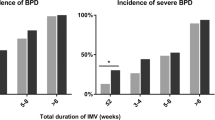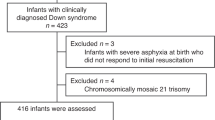Abstract
Background:
Evidence is contradictory whether very low-birth-weight (VLBW, birth weight <1500 g) infants with early neutropenia (NP), especially those born to mothers with preeclampsia experience a greater incidence of nosocomial infection (NI).
Objective:
To investigate whether NP within the first 7 days of life is a risk factor for NI in VLBW infants.
Methods:
Over a 42-month period, we identified all VLBW infants born at ⩽34 weeks gestation who survived for more than 72 h. Infants who had no evidence of early infection, who had at least one complete blood count performed in the first week of life, and who were not given prophylactic recombinant human granulocyte colony-stimulating factor (rhG-CSF) were included in this retrospective study. Early NP was defined as an absolute neutrophil count less than 1500 per μl at any time during the first week of life. NI was defined as the culture of a bacterial or fungal pathogen from a sterile body fluid that was obtained after 72 h of life in an infant with one or more clinical signs of infection.
Results:
A total of 338 VLBW infants were reviewed. Of those, 51 infants were excluded because of death or onset of an infection before 72 h of age, lack of a complete blood count in the first week of life or treatment with rhG-CSF. Of the remaining 287 infants, NI occurred in 11 of 77 (14.3%) infants with early NP compared to 42 of 210 (20.0%) infants without early NP (P=0.31). Infants who developed NI were smaller and less mature, had lower Apgar scores, were more frequently instrumented with central lines and required a longer duration of parenteral nutrition compared to infants without NI. Infants with NI also had a higher mortality and a greater incidence of necrotizing enterocolitis, severe intraventricular hemorrhage and threshold retinopathy of prematurity. However, using stepwise multivariate logistic regression analysis, only the duration of parenteral nutrition and gestational age were significant risk factors for NI.
Conclusion:
Our data do not support the hypothesis that early NP increases the risk for NI in VLBW infants.
This is a preview of subscription content, access via your institution
Access options
Subscribe to this journal
Receive 12 print issues and online access
$259.00 per year
only $21.58 per issue
Buy this article
- Purchase on Springer Link
- Instant access to full article PDF
Prices may be subject to local taxes which are calculated during checkout


Similar content being viewed by others
References
Fanaroff AA, Korones SB, Wright LL, Wright EC, Poland RL, Bauer CB et al. A controlled trial of intravenous immune globulin to reduce nosocomial infections in very-low-birth-weight infants. N Engl J Med 1994; 330: 1107–1113.
Stoll BJ, Hansen N, Fanaroff AA, Wright LL, Carlo WA, Ehrenkranz RA et al. Late-onset sepsis in very low birth weight neonates: the experience of the NICHD Neonatal Research Network. Pediatrics 2002; 110: 285–291.
Kaufman D, Fairchild KD . Clinical microbiology of bacterial and fungal sepsis in very-low-birth-weight infants. Clin Microbiol Rev 2004; 17: 638–680.
Stoll BJ, Gordon T, Korones SB, Shankaran S, Tyson JE, Bauer CR et al. Late-onset sepsis in very low birth weight neonates: a report from the National Institute of Child Health and Human Development Neonatal Research Network. J Pediatr 1996; 129: 63–71.
Makhoul IR, Sujov P, Smolkin T, Lusky A, Reichman B . Epidemiological, clinical, and microbiological characteristics of late-onset sepsis among very low birth weight infants in Israel: a national survey. Pediatrics 2002; 109: 34–39.
Auriti C, Maccallini A, Di Liso G, Di Ciommo V, Ronchetti MP, Orzalesi M . Risk factors for nosocomila infections in a neonatal intensive-care unit. J Hosp Infect 2003; 53: 25–30.
Manzoni P, Maestri A, Leonessa M, Mostert M, Farina D, Gomirato G . Fungal and bacterial sepsis and threshold ROP in preterm very low birth weight neonates. J Perinatol 2006; 26: 23–30.
Schelonka RL, Infante AJ . Neonatal immunology. Semin Perinatol 1998; 22: 2–14.
Yang KD, Chen MZ, Teng RJ, Yang MY, Liu HC, Chen RF et al. A model to study antioxidant regulation of endotoxemia-modulated neonatal granulopoiesis and granulocyte apoptosis. Pediatr Res 2000; 48: 829–834.
Zafar N, Wallace CM, Kieffer P, Schroeder P, Schootman M, Hamvas A . Improving survival of vulnerable infants increases neonatal intensive care unit nosocomial infection rate. Arch Pediatr Adolesc Med 2001; 155: 1098–1104.
Kumar P . Effect of decreased use of postnatal corticosteroids on morbidity in extremely low birthweight infants. Am J Perinatol 2005; 22: 77–81.
Manroe BL, Weinberg AG, Rosenfeld CR, Browne R . The neonatal blood count in health and disease. I. Reference values for neutrophilic cells. J Pediatr 1979; 95: 89–98.
Davies NP, Buggins AGS, Snijders RJM, Jenkins E, Layton DM, Nicolaides KH . Blood leukocyte count in the human fetus. Arch Dis Child 1992; 67: 399.
Ohlsson A, Lacy JB . Intravenous immunoglobulin for preventing infection in preterm and/or low-birth-weight infants. Cochrane Database Syst Rev 2004: CD000361.
Craft AP, Finer NN, Barrington KJ . Vancomycin for prophylaxis against sepsis in preterm neonates. Cochrane Database Syst Rev 2000: CD001971.
Kocherlakota P, La Gamma EF . Preliminary report: rhG-CSF may reduce the incidence of neonatal sepsis in prolonged preeclampsia-associated neutropenia. Pediatrics 1998; 102: 1107–1111.
Funke A, Berner R, Traichel B, Schmeisser D, Leititis JU, Niemeyer CM . Frequency, natural course, and outcome of neonatal neutropenia. Pediatrics 2000; 106: 45–51.
Juul SE, Hayes JW, McPherson RJ . Evaluation of neutropenia and neutrophilia in hospitalized preterm infants. J Perinatol 2004; 24: 150–157.
Cadnapaphornchai M, Faix RG . Increased nosocomial infection in neutropenic low birth weight (2000 g or less) infants of hypertensive mothers. J Pediatr 1992; 121: 956–961.
Koenig JM, Christensen RD . Incidence, neutrophil kinetics, and natural history of neonatal neutropenia associated with maternal hypertension. N Engl J Med 1989; 321: 557–562.
Gray PH, Rodwell RL . Neonatal neutropenia associated with maternal hypertension poses a risk for nosocomial infection. Eur J Pediatr 1999; 158: 71–73.
Mouzinho A, Rosenfeld CR, Sanchez PJ, Risser R . Revised reference ranges for circulating neutrophils in very-low-birth-weight neonates. Pediatrics 1994; 94: 76–82.
Baley JE, Stork EK, Warkentin PI, Shurin SB . Neonatal neutropenia: clinical manifestations, cause and outcome. Am J Dis Child 1988; 142: 1161–1165.
Engle WD, Rosenfeld CR . Neutropenia in high-risk neonates. J Pediatr 1984; 105: 982–986.
Gessler P, Luders R, Konig S, Haas N, Lasch P, Kachel W . Neonatal neutropenia in low birth weight premature infants. Am J Perinatol 1995; 12: 34–38.
Mouzinho A, Rosenfeld CR, Sanchez PJ, Risser R . Effect of maternal hypertension on neonatal neutropenia and risk of nosocomial infection. Pediatrics 1992; 90: 430–435.
Walsh MC, Kliegman RM . Necrotizing enterocolitis: treatment based on staging criteria. Pediatr Clin North Am 1986; 33: 179–201.
Papile LA, Burnstein J, Burnstein R, Koffler H . Incidence and evolution of subependymal and intraventricular hemorrhage: a study of infants with birthweight less than 1500 gm. J Pediatr 1978; 92: 529–534.
Girard R, Fabry J, Meynet R, Lambert DC, Sepetjan M . Costs of nosocomial infection in a neonatal unit. J Hosp Infect 1983; 4: 361–366.
Freeman J, Epstein MF, Smith NE, Platt R, Sidebottom DG, Goldmann DA . Extra hospital stay and antibiotic usage with nosocomial coagulase-negative staphylococcal bacteremia in two neonatal intensive care unit populations. Am J Dis Child 1990; 144: 324–329.
Baker CJ, Melish ME, Hall RT, Casto DT, Vasan U, Givner LB . Intravenous immune globulin for the prevention of nosocomial infection in low-birth-weight neonates. The multicenter Group for the Study of Immune Globulin in Neonates. N Engl J Med 1992; 327: 213–219.
Gray JE, Richardson DK, McCormick MC, Goldmann D . Coagulase-negative staphylococcal bacteremia among very low birth weight infants: relation to admission illness severity. Pediatrics 1995; 95: 225–230.
Sohn AH, Sinkowitz-Cochran RL, Stover BH, Siegel JD, Jarvis WR . Prevalence of nosocomial infections in neonatal intensive care units: results from the first national point-prevalence survey. J Pediatr 2001; 139: 821–827.
Engle WD, Rosenfeld CR . Neutropenia in high-risk neonates. J Pediatr 1984; 105: 982–986.
Baley JE, Stork EK, Warkentin PI, Shurin SB . Neonatal neutropenia: clinical manifestation, cause and outcome. Am J Dis Child 1988; 142: 1161–1165.
Gessler P, Luders R, Konig S, Haas N, Lasch P, Kachel W . Neonatal neutropenia in low birth weight premature infants. Am J Perinatol 1995; 12: 34–38.
Doron MW, Makhlouf RA, Katz VL, Lawson EE, Stiles AD . Increased incidence of sepsis at birth in neutropenic infants of mothers with preeclampsia. J Pediatr 1994; 125: 452–458.
Paul DA, Leef KH, Sciscione A, Tuttle DJ, Stefano JL . Preeclampsia does not increase the risk for culture proven sepsis in very low birth weight infants. Am J Perinatol 1999; 16: 365–372.
Tsao PN, Teng RJ, Tang JR, Yau KI . Granulocyte colony-stimulating factor in the cord blood of premature neonates born to mothers with pregnancy-induced hypertension. J Pediatr 1999; 135: 56–59.
Acknowledgements
Part of the results were presented as a poster in 2005 Society of Pediatric Research meeting in Washington, DC.
Author information
Authors and Affiliations
Corresponding author
Rights and permissions
About this article
Cite this article
Teng, RJ., Wu, TJ., Garrison, R. et al. Early neutropenia is not associated with an increased rate of nosocomial infection in very low-birth-weight infants. J Perinatol 29, 219–224 (2009). https://doi.org/10.1038/jp.2008.202
Received:
Revised:
Accepted:
Published:
Issue Date:
DOI: https://doi.org/10.1038/jp.2008.202
Keywords
This article is cited by
-
Delivery-based criteria for empiric antibiotic administration among preterm infants
Journal of Perinatology (2021)



